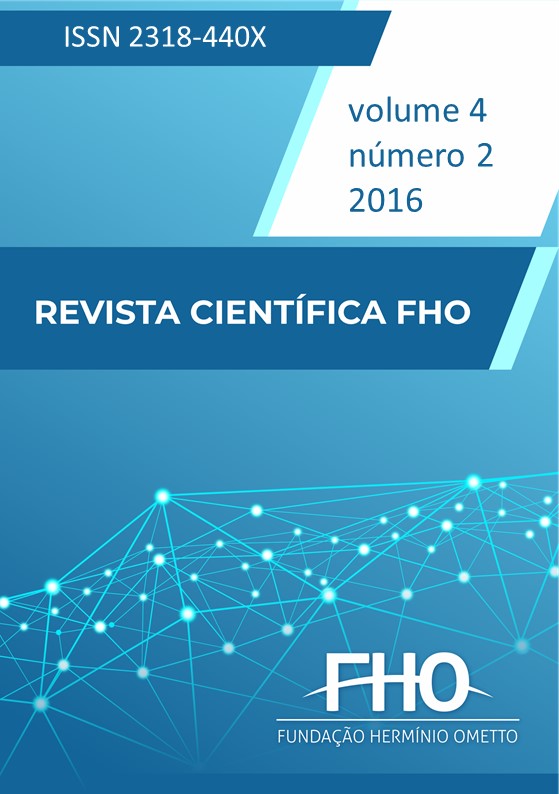Abstract
The drug application system is considered complex and dynamic because it comprehends several steps, such as selecting and obtaining the drug, prescribing, preparing, dispensing and administering the drug, in addition to monitoring the patient. This study aimed to create and
implement a plan of application of high surveillance drugs in an Intensive Care Unit. The method used was descriptive, with bibliographical survey, mapping of the process, creation and implementation of the Drug Application Plan. A flowchart was established to verify the receipt of the drug, its administration and patient monitoring, which made it possible to improve the process of receiving and administering high surveillance drugs in order to guarantee a safe care.
References
BERDOT, S. et al. Evaluation of drug administration errors in a teaching hospital. BMC Health Services Research, v. 12, p. 60, 2012. Disponível em: http://bmchealthservres.biomedcentral.com/articles/10.1186/1472-6963-12-60. Acesso em: 31 maio 2017.
BOHOMOL, E. Erros de medicação: estudo descritivo das classes dos medicamentos e medicamentos de alta vigilância. Escola Anna Nery, Rio de Janeiro, v. 18, n. 2, abr./jun. 2014.
Disponível em: http://www.scielo.br/scielo.php?pid=S141481452014000200311&script=sci_arttext. Acesso em: 22 maio 2017.
BREEDING, J. et al. Medication Error Minimization Scheme (MEMS) in an adult tertiary intensive care unit (ICU) 2009-2011. Australian Critical Care, v. 26, n. 2, p. 58-75, maio 2013.
Disponível em: http://www.australiancriticalcare.com/article/S1036-7314(12)00085-9/references. Acesso em: 24 maio 2017.
CAPUCHO, H. C.; ARNAS, E. R.; CASSIANI, S. H. B. Segurança do paciente: comparação entre notificações voluntárias manuscritas e informatizadas sobre incidentes em saúde. Revista
Gaúcha de Enfermagem, Porto Alegre, v. 34, n. 1, mar. 2013. Disponível em: http://www.scielo.br/scielo.php?pid=S1983-14472013000100021&script=sci_arttext. Acesso em: 24 maio 2017.
FERNANDES, H. S.; PULZI JR., S. A. P.; COSTA FILHO, R. Qualidade em terapia intensiva. Revista da Sociedade Brasileira de Clínica Médica, São Paulo, n. 8, p. 37-45, 2010. Disponível em: http://files.bvs.br/upload/S/1679-1010/2010/v8n1/a009.pdf. Acesso em: 22 maio 2017.
FERREIRA, P. C. et al. Evento adverso versus erro de medicação: percepções da equipe de enfermagem atuante em terapia intensiva. Revista de Pesquisa Cuidado é Fundamental Online, Rio de Janeiro, v. 6, n. 2, p. 725-734, abr./jun. 2014. Disponível em: http://www.seer.unirio.br/index.php/cuidadofundamental/article/viewFile/3088/pdf_1281. Acesso em: 24 maio 2017.
NUNES, F. D. O. et al. Segurança do paciente: como a enfermagem vem contribuindo para a questão? Revista de Pesquisa Cuidado é Fundamental Online, Rio de Janeiro, v. 6, n. 2,
p. 841-847, abr./jun. 2014. Disponível em: http://www.seer.unirio.br/index.php/cuidadofundamental/article/viewFile/3007/pdf_1297. Acesso em: 24 maio 2017.
PEDREIRA, L. C.; BRANDÃO, A. S.; REIS, A. M. Evento adverso no idoso em Unidade de Terapia Intensiva. Revista Brasileira de Enfermagem, Brasília, v. 66, n. 3, maio/jun. 2013. Disponível em: http://www.scielo.br/pdf/reben/v66n3/a19v66n3.pdf. Acesso em: 22 maio 2017.
RODRIGUES, C. S.; OLIVEIRA, L. C. Erros na administração de antibióticos em unidade de terapia intensiva de hospital de ensino. Revista Eletrônica de Enfermagem [Internet], Goiânia, v. 12, n. 3, p. 511-519, set. 2010. Disponível em: http://www.fen.ufg.br/fen_revista/v12/n3/v12n3a14.htm. Acesso em: 24 maio 2017.
ROSA, M. B. et al. Erros na prescrição hospitalar de medicamentos potencialmente perigosos. Revista de Saúde Pública, São Paulo, v. 43, n. 3, p. 490-498, 2009. Disponível em:
http://www.scielo.br/pdf/rsp/v43n3/7265.pdf. Acesso em: 15 out. 2015.
ROZENFELD, S.; GIORDANI, F.; COELHO, S. Eventos adversos a medicamentos en hospital terciario: estudio piloto con rastreadores. Revista de Saúde Pública, São Paulo, v. 47, n.
, dez. 2013. Disponível em: http://www.scielo.br/scielo.php?script=sci_arttext&pid=S0034-89102013000601102. Acesso em: 24 maio 2015.
SILVA, L. D.; CAMERINE, F. G. Análise da administração de medicamentos intravenosos em hospital da rede sentinela. Texto & Contexto-Enfermagem, Florianópolis, v. 21, n. 3,
jul./set. 2012. Disponível em: http://www.scielo.br/scielo.php?pid=S0104-07072012000300019&script=sci_arttext. Acesso em: 24 maio 2015.
TEIXEIRA, T. C. A.; CASSIANI, S. H. B. Análise de causa raiz de acidentes por quedas e erros de medicação em hospital. Acta Paulista de Enfermagem, São Paulo, v. 27, n. 2, mar./abr. 2014. Disponível em: http://www.scielo.br/pdf/ape/v27n2/0103-2100-ape-27-02-0100.pdf. Acesso em: 22 maio 2015.
YAMAMOTO, M. S.; PETERLINE, M. A. S.; BOHOMOL, E. Notificação espontânea de erros de medicação em hospital universitário pediátrico. Acta Paulista de Enfermagem, São Paulo, v. 24, n. 6, 2011. Disponível em: http://www.scielo.br/scielo.php?pid=S0103-21002011000600006&script=sci_arttext. Acesso em: 24 maio 2015.

This work is licensed under a Creative Commons Attribution-NonCommercial 4.0 International License.
Copyright (c) 2016 Ana Lúcia da Silva; Luis Angelo Ozan Maligieri
